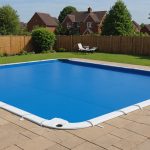Top Poolside Plants Perfect for Thriving in the UK Climate
When it comes to creating a stunning and inviting pool area, the right plants can make all the difference. Not only do they add a touch of natural beauty, but they also help in maintaining a healthy and balanced environment around your pool. However, selecting the best plants for your poolside in the UK climate can be a bit challenging due to the specific conditions and requirements involved. Here’s a comprehensive guide to help you choose the perfect plants for your pool area.
Understanding the UK Climate and Pool Environment
Before diving into the best plants, it’s crucial to understand the UK climate and the unique conditions of a pool area. The UK is known for its temperate maritime climate, characterized by cool winters and mild summers. This means your plants need to be resilient to varying temperatures, rainfall, and potential frost.
Avez-vous vu cela : Top Strategies to Prevent Winter Freeze Damage in UK Swimming Pools
Additionally, the pool environment presents its own set of challenges, including exposure to pool chemicals, increased humidity, and varying levels of sun exposure. Here are some key factors to consider:
- Sun Exposure: Most pool areas receive full sun to partial shade. Choose plants that can tolerate the amount of sunlight your area receives.
- Chemical Resistance: Plants around the pool need to be resistant to the chemicals used in pool maintenance.
- Moisture Levels: The pool area can be quite humid, but some plants may require well-drained soil to thrive.
- Temperature Fluctuations: Plants should be able to withstand the temperature variations typical of the UK climate.
Best Plants for Poolside Gardens
Here are some of the best plants that can thrive in the UK climate and the poolside environment.
Sujet a lire : Top Safety Pool Covers for UK Homes: Your Ultimate Guide to Accident Prevention
Drought Tolerant Plants
These plants are ideal for areas that may experience occasional droughts and can handle the chemical exposure around pools.
-
Windmill Palms
-
These palms are highly adaptable and can tolerate a range of conditions, including full sun and well-drained soil. They are also resistant to many pool chemicals[2].
-
Height: Up to 10-15 feet
-
Sun Exposure: Full sun to partial shade
-
Soil: Well-drained soil
-
Japanese Aralia
-
Known for its elegant foliage, Japanese Aralia is a low-maintenance plant that can thrive in containers around the pool. It prefers well-drained soil and partial shade[2].
-
Height: Up to 6-8 feet
-
Sun Exposure: Partial shade
-
Soil: Well-drained soil
Flowering Plants
Flowering plants add a vibrant touch to your pool area and can attract pollinators and other beneficial insects.
-
Mimosa Trees
-
While they can grow quite tall, mimosa trees can be pruned to maintain a smaller size. They are known for their fragrant, fringy blooms that attract butterflies and bees. However, they are considered invasive in some areas, so careful management is necessary[4].
-
Height: Up to 40 feet (can be pruned)
-
Sun Exposure: Full sun
-
Soil: Well-drained soil
-
Winter Flowering Violas
-
These small, delicate flowers are perfect for adding color to your pool area during the winter months. They are hardy and can thrive in a variety of soil conditions[5].
-
Height: Up to 6-8 inches
-
Sun Exposure: Full sun to partial shade
-
Soil: Moist, well-drained soil
Ground Cover and Low Maintenance Plants
Ground cover plants are excellent for filling in gaps and creating a cohesive look around your pool.
-
Artificial Grass
-
For a low-maintenance option, artificial grass is a great choice. It can withstand pool chemicals and provides a soft, slip-resistant surface[2].
-
Maintenance: Regular cleaning to remove debris
-
Sun Exposure: Full sun to partial shade
-
Soil: Not required
-
Heuchera
-
This hardy perennial is perfect for winter containers and can thrive in shady spots. It adds a deep-purple hue to your garden and works well with small ornamental grasses[5].
-
Height: Up to 12-18 inches
-
Sun Exposure: Partial shade
-
Soil: Well-drained soil
Plant Selection Tips
When selecting plants for your pool area, here are some tips to keep in mind:
Plant Placement
- Consider Sunlight and Shade: Choose plants that are well-suited to the amount of sunlight and shade your pool area receives.
- Chemical Tolerance: Ensure the plants you select can tolerate the chemicals used in your pool.
- Soil Conditions: Select plants that thrive in the soil type you have. For example, if your soil is prone to waterlogging, choose plants with low tolerance for flooding[1].
Container Gardening
- Flexibility and Mobility: Use containers to add flexibility and mobility to your pool landscape. This allows you to move plants as needed or change your pool’s look with the seasons[2].
- Drainage: Ensure proper drainage in your containers to avoid water pooling on the surface.
Balanced Garden Design
- Mix of Plant Types: Aim for a balanced mix of plant types, sizes, and colors to create depth and harmony. Keep taller plants towards the back and smaller plants towards the front[2].
Managing Pests and Diseases
In addition to climate change, pests and diseases are significant threats to your poolside plants. Here are some strategies to manage these risks:
Monitoring and Prevention
- Regular Inspection: Regularly inspect your plants for signs of pests or diseases.
- Proactive Measures: Implement proactive measures such as monitoring for pests like ash dieback, Ips typographus, and oak processionary moth, which are common in the UK[1].
Resilient Plant Species
- Choose Resilient Species: Select plant species that are known to be resilient to pests and diseases. For example, deciduous trees like oak and birch can tolerate frost and don’t require covering[3].
Practical Insights and Actionable Advice
Here are some practical tips to help you get started:
Creating a Rain Garden
- Utilize Rainwater: Consider creating a rain garden to utilize rainwater and reduce the risk of waterlogging around your pool area.
- Plant Selection: Choose plants that thrive in moist conditions but can also tolerate periods of drought.
Mulching and Watering
- Mulch Around Plants: Mulch around the base of your plants to retain moisture and reduce the need for frequent watering.
- Water Wisely: Water your plants wisely, ensuring the soil is moist but not waterlogged.
Table: Best Plants for Poolside Gardens in the UK
| Plant Name | Height | Sun Exposure | Soil Requirements | Chemical Tolerance | Maintenance |
|---|---|---|---|---|---|
| Windmill Palms | 10-15 feet | Full sun to partial shade | Well-drained soil | High | Low |
| Japanese Aralia | 6-8 feet | Partial shade | Well-drained soil | Medium | Low |
| Mimosa Trees | 40 feet (pruned) | Full sun | Well-drained soil | Medium | Medium |
| Winter Flowering Violas | 6-8 inches | Full sun to partial shade | Moist, well-drained soil | Low | Low |
| Artificial Grass | N/A | Full sun to partial shade | Not required | High | Low |
| Heuchera | 12-18 inches | Partial shade | Well-drained soil | Low | Low |
Quotes from Experts
-
Richard Cobb, Local Partnership Advisor for the South East and London: “Trees and woodlands are one of our most effective tools for tackling the climate and nature crisis, but they’re at huge risk from climate change and pests and diseases. It’s crucial to choose resilient plant species and implement proactive management strategies”[1].
-
Ward Dilmore, Founder and Head Landscape Designer at Petrus: “Plants have what is called a cambium layer, which is a series of tissues that make up a plant’s anatomy and protect it from various diseases and cold temperatures. The thinner the cambium layer, the less cold hardy the plant is”[3].
-
Jen McDonald, Gardening Professional at Garden Girls: “Heuchera is a fabulous hardy perennial. I love ‘Frosted Violet’ which is low-maintenance and works well in floral displays. Its deep-purple hue, combined with hints of silver, lend particularly well to autumn and winter gardens”[5].
Creating a beautiful and resilient poolside garden in the UK requires careful consideration of the climate, pool environment, and the specific needs of the plants you choose. By selecting drought-tolerant, flowering, and low-maintenance plants, and by implementing good gardening practices such as proper drainage, mulching, and regular inspection for pests and diseases, you can ensure your pool area remains a serene and inviting oasis all year round.
Whether you opt for the elegant Windmill Palms, the vibrant Mimosa Trees, or the hardy Heuchera, each plant brings its unique charm and benefits to your garden. Remember to always choose plants that are well-suited to your specific climate and pool conditions, and don’t hesitate to seek advice from gardening experts to ensure your garden thrives. With the right plants and a little care, your poolside garden can become a stunning and relaxing retreat that enhances your outdoor living experience.











